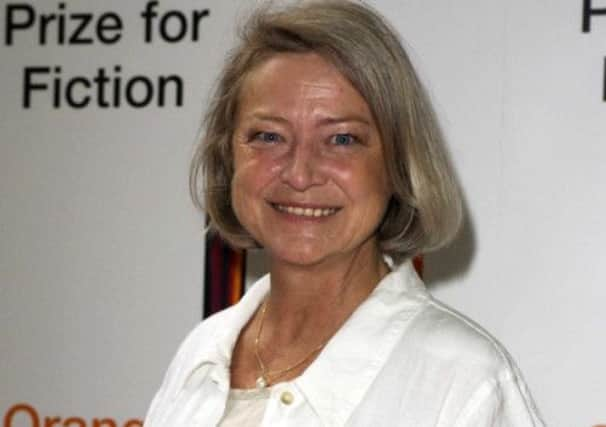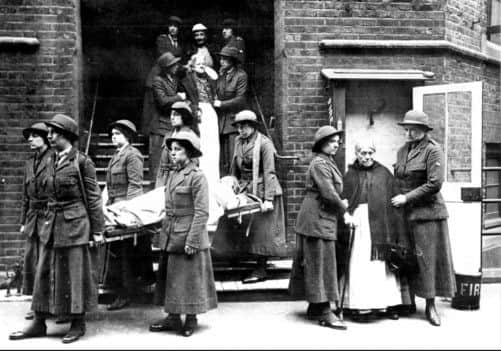Kate Adie, first lady of the flak jacket


Sooner or later, a conversation with Kate Adie will inevitably turn to conflict. But for the moment, we’re discussing football. Having grown up in Sunderland, Adie admits to an “inate fascination” with the game. It has proved a useful way of bonding with male colleagues in the war zones of the world.
In the course of researching her new book, Fighting on the Home Front: The Legacy of Women in World War One, she uncovered a little known chapter in the history of the beautiful game. During the First World War, women played football. They played in stadiums, in front of crowds of thousands, and reports were written up in the sports pages of newspapers. And then the war ended, the men came back, and the FA changed its rules about women playing on its pitches. The “level playing field” disappeared. Of course women do play football today, I say, cautiously. “And how much patronising stuff do you read about it? Mmm! You see what I mean by there still being a lot to do.” She laughs, a deep, conspiratorial chuckle.
Advertisement
Hide AdIt’s a rare moment of warmth. When I ask what else there is “still to do”, the frosty Adie returns. “I don’t concentrate on it. All I know is that there’s more to do. There are still areas where we are moving slowly, and they are obvious to everyone.” Our first lady of the flak jacket is fierce about guarding her privacy, but it seems the list of prohibited topics is growing. That crisply authoritative voice which brought us the news from Bosnia, Libya and Tiananmen Square, is never less than clear about what it will and won’t discuss.


Mostly, we’re discussing her latest book. Fighting On The Home Front looks, on the face of it, like another First World War anniversary book with a famous name attached, but in fact it is a passionate history of how things have changed for women in the last 100 years. When she talks about the prejudices and misogyny of the time, she sounds genuinely angry, and equally admiring of the courage and determination of women to persevere in the face of opposition. “This has been one of the greatest social revolutions we’ve seen. It is very definitely not just a little aside (to the story of the war). Quite frankly, the war would not have been won if women hadn’t worked and changed their roles.”
Women’s stories tend to get neglected in wars, she says. “If you read the story of a battle or a war it’s mainly about military manoeuvres and strategy, understandably because that is what eventually decides the power and who wins. The histories and memoirs are usually written by men. And there is also a fascination with violence, I’ve seen that when I’ve reported wars, the actual hardware, the fighting, the frontlines, they tend to preoccupy people. If you’re a good reporter, I always think, you should not exclude the fact that an entire nation, country or community is always involved in war, they’re never separate from it, and if you take a good hard look at (all of that) you get a better idea of what on earth is going on.”
Since she resigned as chief news correspondent at the BBC 10 years ago, Adie, now 67, has forged herself a new career as presenter of Radio 4’s From Our Own Correspondent, after-dinner speaker and author of books such as Into Danger, Corsets to Camouflage and Nobody’s Child. She moved from London to a cottage in Dorset in 2012, which is where she speaks to me on the phone. She won’t go into detail, other than to say she is busy, and happy, but a picture does leak out around the edges. When she goes – telephone in hand – to answer the door, I hear a high-pitched “Oh!” of pleasure. “I’ve got an enormous posy of sweet peas,” she explains. “I had a party last night and people keep popping round, I’ve got a basket of apples, and now sweet peas, that’s lovely...” for a moment she sounds happily flustered. “Gosh, yes, sorry, we were talking about anti-German riots...”
It all sounds quaint and homely, and I can’t help asking if there isn’t a small part of her that would like to be in Syria. “I don’t talk about these things,” she snaps, a little too quickly, then tries to cover it with a laugh. “I’m ten years out of it. I don’t ever have any regrets.”
Adie started as a technician on Radio Durham, and worked as a producer in local broadcasting before going into reporting. Her big break was as a junior in BBC television news covering a Bank Holiday late shift in May 1980 when the SAS stormed the Iranian embassy. She became one of the BBC’s top correspondents, receiving television awards and an OBE.
Advertisement
Hide AdI want to tell her that she’s a feminist icon. That when she dodged bullets crouching behind a car door, or kneed a Chinese policeman in the groin then delivered a flawless piece-to-camera in her pearl earrings, she was empowering a generation of women journalists to take on the profession on their own terms. But she must have faced chauvinism? “Look, every woman who came into a professional job 40 years ago experienced the attitudes of the times. There was no equal pay law when I started working. I was no different to any other woman in any other job at the time.”
Certainly, she experienced sexism around the world: figures such as Saudi minor royals, Afghan warlords and Iranian clerics, all attempted to ignore her because of her gender. There is a story of an Afghan warlord who refused Adie an interview because she was a woman. “You’re aware all the time that in different parts of the world there are different stages of development that society has got to. And some haven’t developed that much. (Afghanistan) is a country where women have very few rights, are treated like dogs, are second-class citizens, are refused education and are subjected to violence when they attempt to in any way claim their rights as citizens. And it’s all covered up with mutterings about culture.”
Advertisement
Hide AdIn writing about Britain in 1914-18, she uncovered some prejudices which are similarly rank. Pioneering Edinburgh doctor, Elsie Inglis, on approaching the War Office at Edinburgh Castle and offering to supply qualified doctors and nurses for the Front, was told: “Dear lady, do go home, and sit still.” “Patronising, hostile, dismissive. All of these things faced competent, sensible, educated women. I think we’ve forgotten the objections, which we would now find quite unpleasant, of women having smaller brains, being hysterical, being incapable, not able to take on responsibility, being fluffy and disorganised. All of this was levelled permanently at women,” she says.
But Elsie Inglis didn’t go home, and neither did plenty of other women. They organised and fund-raised, ran field hospitals (albeit without official Government recognition), worked in fields and factories, took up essential jobs in shipyards and railways and thousands of working-class women worked in munitions factories.
Adie begins her chapter on the munitionettes by describing how, in the Holiday Inn Hotel in Sarajevo in 1992 (“Window glass – well, who needs it... it just flies in and causes damage...”), she slept through a major explosion in the building next door, which turned out to be a secret munitions factory. The point is that explosives have a tendency to blow up, not always when they’re meant to. It was dangerous work. When Nobel’s Explosives Works at Ardeer exploded in July 1915, the blast was so big the ground shook in Kilmarnock seven miles away. Due to wartime censorship, the number of casualties was never reported.
“In any war there is a concealment of certain kinds of setbacks because it’s propaganda for the enemy. There is no doubt about it, there were explosions and accidents in factories, and probably a whole list of minor ones which never ever were made public,” says Adie. At the same time, the munitionettes experienced a radical liberation. Women who were expected to live with their parents until they married were now living away from home, with other young women. They wore trousers to work, had money in their pockets and the confidence to go into a pub and order a drink unchaperoned.
“There were two sorts of objection (to women’s work). The first was that women couldn’t do things. Well, they proved they could, they could do the heavy work, the dangerous work, the clever work, the jobs which demanded all sorts of qualities that were thought to be only possessed by men.”
I ask if Adie found herself wondering what she would be doing if she had lived at that time. “No. I don’t think you can mentally shift yourself back to these times. We are so very different.” But I see echoes of her in the steely-eyed courage of the women doctors, ambulance drivers and public speakers who knew their worth and weren’t going to let anything get in their way.
Advertisement
Hide AdAdie has said that she made her way as a journalist because she was curious. After a lifetime of achievements as a reporter, what is she curious about now? One word. No hesitation. “Everything.”
• Fighting on the Home Front: The Legacy of Women in World War One, is published by Hodder & Stoughton, priced £20.